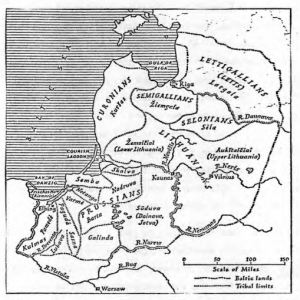Part I
The History of Lithuania
Lithuania lies southeast of the Baltic Sea and is surrounded by Latvia, Byelorussia, Poland, and East Prussia, or what is now called the Region of Kaliningrad. It covers an area of 65,200 square kilometers or 24,500 square miles, and is smaller than Ohio but larger than Belgium, Denmark, Holland, Ireland, or Switzerland. It’s language, Lithuanian, belongs to the Indoeuropean family, as do the Germanic, Romance, and Slavic tongues, but it is not linguistically part of these branches and constitutes a separate Indoeuropean division. Of all the Indoeuropean languages, Lithuanian has changed the least and is therefore of great value to linguists in determining Indoeuropean origins. The Roman historian Tacitus called the people of this branch aesti (Aestorium Gentes.)[1] Since the 19th century the name Balts has been used to classify the Lithuanians and their only living linguistic relatives, the Latvians.
For millenia the Balts have lived along the border of the Baltic Sea, with the Finno-Ugrians as their neighbors to the north, and the Slavic tribes to the west across the Vistula River. At first the Balts lived in tribes which were territorial communities,[2] which archeological findings show maintained trade relations with distant lands. Bronze, iron, silver and glass artifacts found in hill fortifications and graves clearly reveal the Balts had reached an advanced culture by 1000 B.C., and had contacts with eastern and western European nations.[3] Roman coins and other articles give evidence that they also carried on commercial exchange with the classical worlds and that “amber” (semi-precious gems) moved south along the “amber route” to Rome.[4] In the 9th century the Vikings, after years of friendly relations with Baltic nations, established a colony in the ancient Prussian lands along the Baltic Sea.

While the Teutonic Knights continued their crusades to convert “the last pagans in Europe,” the Lithuanian state began to emerge. It was created from two closely related tribes whose names derive from the areas they inhabited. The tribes living in the lower regions of the Nemunas River were called the Žemaičiai, or Lowlanders (Samogitians). Those living in the upper regions were called the Aukštaičiai, or Highlanders. The consolidation started in the beginning of the 13th century when regional leaders began to unite into larger units, although it is still not clear whether the union was brought about by internal or external causes. The first significant documentation of this amalgamation is the fragment of a treaty made in 1219 between twenty-one noblemen from High and Low Lithuania and the nobles of Volhynia.
Once national awareness began, the goal of the Teutonic Knights became more difficult. Nevertheless, the Order was not deterred and battles between the two continued. Despite this pressure, the country resisted Christianity and stoutly defended its paganism which lasted almost 150 years longer than in surrounding states.
Slowly, the people from High Lithuania, under their ruler Mindaugas (Mindovg), became the nucleus of a Lithuanian state. But many noblemen, jealous of Mindaugas’ growing power, united against him, assisted by the Duke of Volhynia and the Knights of Livonia. Under the pressure of this combined force, Mindaugas decided to accept Christianity. Shortly afterwards, in 1253, he was crowned king, thus becoming the first Christian ruler of Lithuania.[6]However, continual pressures from the Teutonic Knights to take over Lithuania caused Mindaugas to unite with the pagan Samogitian leader, Treniota, to ward off the enemy. Unfortunately, a victim of secret plots and schemes, Mindaugas was killed in 1263, but by then he had built a solid foundation for the Lithuanian state.
The next Lithuanian ruler was Traidenis (1268-82), who strongly defended paganism and therefore gave the Order an excuse for further interference.
